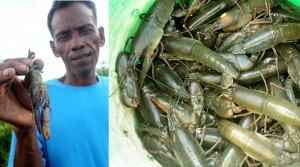
A shrimp that is among the world’s fastest and that which produces the loudest sounds underwater is now taking the limelight among Bohol eco-tourists of Abucayan Norte in Calape.
The snapping shrimp, or otherwise known as the pistol shrimp (takla) grows one claw bigger than the other, and that extra-large pincer is what it uses to bring food to its table.
And no, the snapping shrimp, doesn’t directly catch its food with its unusually large asymmetrical claws.
It catches its food by laying in ambush from its burrow in the mud or reef, once claw on the ready.
As soon as its antenna detects fish or food passing by, it inches out of its burrows and fires its weapon: a snap so quick it produces the loudest underwater sounds that stun prey and often killing small fish.
Then it drags its often stunned or dead catch to its burrow as a ready meal.
The snapping shrimp grows to only 1.2 inches (3.5 cm) long. It is distinctive for its remarkably disproportionate large claw, which is sometimes larger than half the shrimp’s body. The claw can be on either arm of the body, and unlike most shrimp claws, these do not have typical pincers at the end. Rather, it has a pistol-like feature made of two parts. A joint allows the “hammer” part to move backward into a right-angled position.
When released, it snaps into the other part of the claw, emitting an enormously powerful wave of bubbles capable of stunning larger fish and breaking small glass jars, states an article at the wikipedia.
In fact, National Geographic experts claim that the quick snap of its claw, a pistol shrimp stuns prey with a “bubble bullet” that travels as fast as a car.
As to its snapping weapon, the snapping shrimp competes with much larger animals such as the sperm whale and beluga whale for the title of loudest animal in the sea, scientific sources revealed.
The animal snaps a specialized claw shut to create a cavitation bubble that generates acoustic pressures of up to 80 kPa at a distance of 4 cm from the claw. As it extends out from the claw, the bubble reaches speeds of 60 miles per hour (97 km/h) and releases a sound reaching 218 decibels. The pressure is strong enough to kill small fish, laboratory studies on the pistol shrimp showed.
In the mangrove mudflats of Calape, fishermen catch these snapping shrimps from their burrows using the same weapon these feisty crustaceans use: sound.
When a fisherman finds a snapping turtle burrow, it pats on the hole entrance: one that traps air into the water packed burrows and temporarily stuns the snapping shrimp enough for the fisherman to draw deep into the burrow and pick the limp shrimp, which goes into a pail.
A long cherished tradition of fishing in Calape, snapping shrimp gathering, or pagpanakla, is now catching the attention of eco-tourists who visit Abucayan, to witness how these delicious crustaceans can be caught.
Japan International Cooperation Agency’s Sustainable Environment for Panglao Project (SEPP) establishes Calape takla gathering industry as among the most interesting community livelihood efforts in Bohol .
Other than gathering takla, tourists here are also given the chance to pull crab traps (sapyaw) and can take a board walk over a green crab enclosure as they watch how fishermen harvest crabs, clams and shrimps. (rac/PIA-7Bohol)
